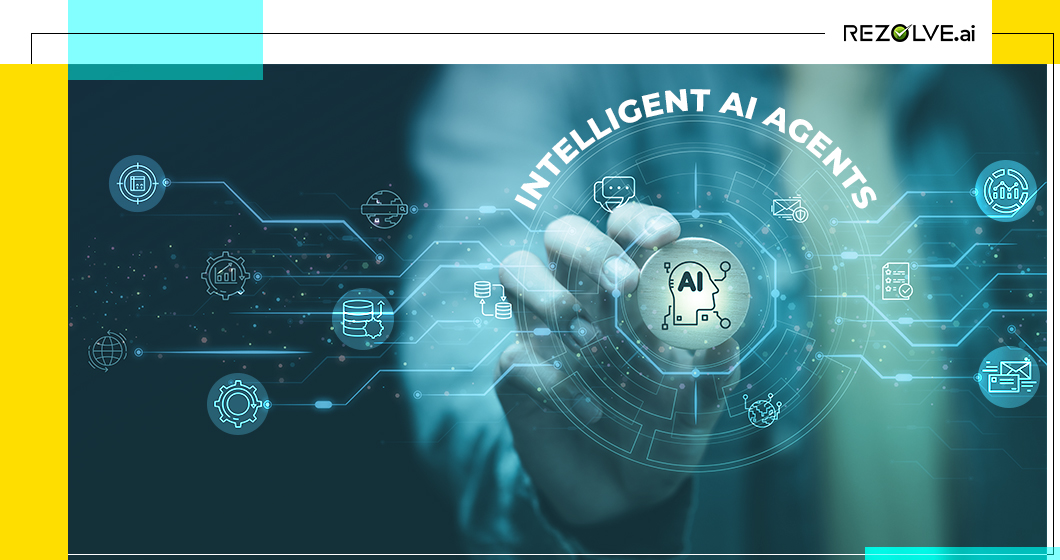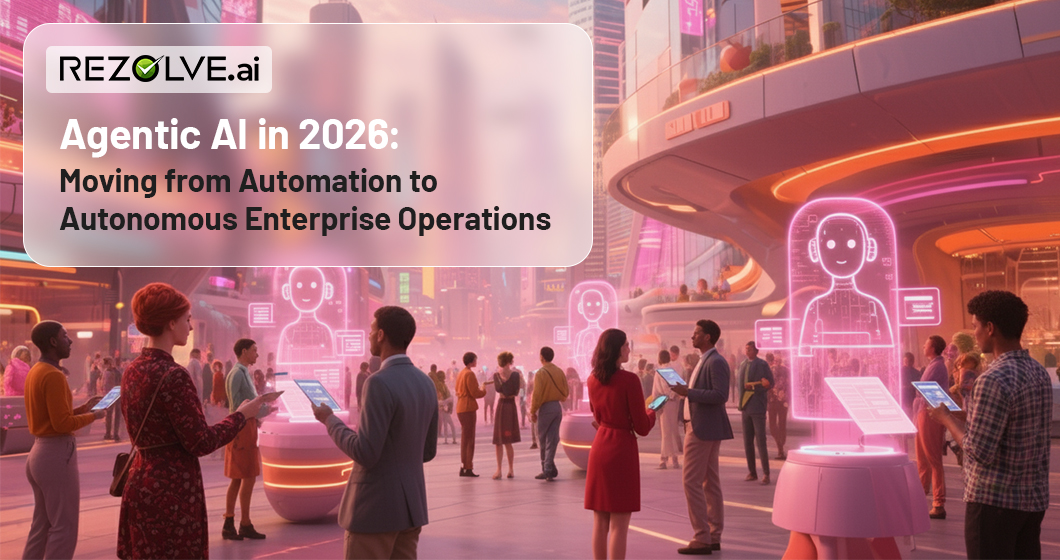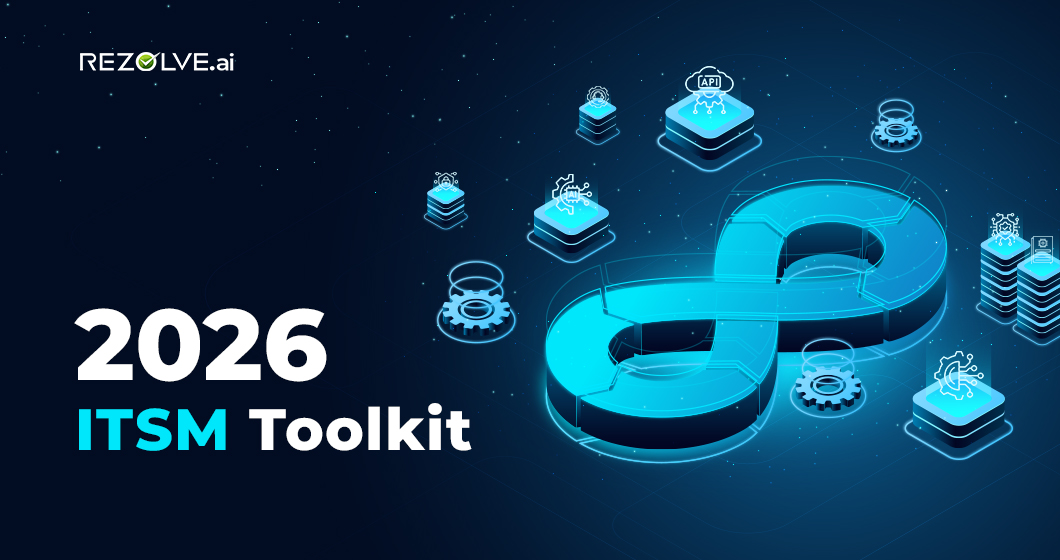Gartner forecasts that by 2028 one-third of enterprise applications will embed autonomous, “agentic” AI, up from practically none today. In the same time frame, 15 percent of routine business decisions are expected to be made by AI agents. For IT service-management (ITSM) leaders wrestling with round-the-clock demand and shrinking budgets, those numbers are impossible to ignore.
This guide demystifies intelligent AI agents: what they are, how they work, why they matter to ITSM, and how platforms such as Rezolve.ai are already putting them to work. By the end you’ll know exactly where autonomous agents fit into the modern service desk and how to roll them out with confidence.
Intelligent AI Agents Explained: Definition and Core Principles
A standard bot waits for you to type an exact command and then follows a rigid script. An intelligent agent, on the other hand, begins with a broad objective, like “keep the VPN operational” and does the rest itself: monitoring system signals, diagnosing issues, deciding on the best fix, and carrying it out without coming back for more directions.
Key principles underpin every serious agent implementation:
- Autonomy — The agent initiates activity without continuous human prompting, operating within clearly defined guardrails.
- Goal orientation — It receives objectives (“diagnose and fix VPN outages”) rather than step-by-step scripts.
- Perception and context — Using sensors, log streams, API responses, or user dialogue, the agent builds a real-time picture of its world.
- Reasoning and planning — It creates and updates plans, decomposing big goals into executable subtasks.
- Action — The agent calls APIs, runs scripts, updates databases, files tickets, or even triggers robotic processes in the physical world.
- Learning — With each interaction, the system captures outcomes, refining future decisions and boosting accuracy over time.
How Intelligent Agents Work: The Perceive-Reason-Act Cycle
Agentic AI runs on a simple but powerful rhythm: perceive, reason, act. First, the agent soaks up signals, anything from an error log or a chat message to a monitoring alert or IoT sensor ping, then enriches that raw data with context like priority, user history, and system details. Next comes the thinking: drawing on large-language models, knowledge bases, and rule engines, it weighs possible causes and maps out a plan, often breaking tough problems into clear, auditable steps. Finally, it gets busy resetting an Active Directory password, spinning up a fresh cloud container, or looping in a human expert when policy demands. Every action is logged and measured, feeding the agent’s next round of perception.
Because each stage is modular, enterprises can swap in better perception pipelines (e.g., log-analytics services), smarter reasoning models, or new action connectors without rewriting the whole agent.
Why ITSM Leaders Should Care: Five Revenue-Saving Benefits
A brisk technical upgrade is interesting; a demonstrable business payoff is compelling. Intelligent agents deliver both.
1. Round-the-Clock Resolution
Unlike human teams, agents never sleep. Employees on distant time zones get the same instant support as headquarters, pushing mean time to resolution (MTTR) down by up to 50 percent.
2. Ticket Deflection and Self-Healing
Because agents act, they eliminate whole ticket categories. Deployments of Rezolve.ai have shown 75–90 percent of Level-1 tickets handled end-to-end by AI, freeing analysts for complex escalations and strategic projects.
3. Consistency and Compliance
Agents follow playbooks to the letter, tagging incidents correctly, enforcing ITIL processes, and documenting actions automatically. In regulated industries that reliability is priceless: audit trails are complete, and no critical step “slips through the cracks” on a frantic Monday morning.
4. Elastic Scalability
Adding a hundred extra virtual agents costs little more than the compute cycles they consume. Contrast that with the hiring, onboarding, and retention costs of equivalent human staff, especially in high-cost regions. For organizations with seasonal support spikes (think retail Black Friday), on-demand agentic capacity is a financial lifesaver.
5. Data-Driven Insight
Every conversation, decision tree, and automation run becomes structured telemetry. Advanced platforms funnel this stream into analytics engines, revealing chronic pain points, forecasting incident surges, and recommending preventive fixes. Decisions that once relied on anecdotal reports are now backed by live data.
Building Intelligent Agents into Your Service Desk: Best Practices for Success
Rolling out autonomous agents is as much a governance exercise as a technical one. The following fundamentals separate success stories from headline-grabbing failures.
Start Small, Win Early
Start small and go for the low-hanging fruit. Pick the ticket type that clogs your queue—maybe those never-ending password resets or the daily VPN unlock requests—and let the agent handle it end to end. Nail just one or two of these nagging jobs, show the quick wins, and you’ll have skeptics turning into cheerleaders for the bigger automation roadmap.
Integrate Broadly, Securely
An agent only performs miracles if it can reach the systems that matter. Prioritize secure API or RPA connections to identity services, ticketing tools, cloud platforms, and knowledge repositories. Use least-privilege principles so early agents have enough power to help but not enough to harm.
Establish Guardrails and Audit Trails
Set clear policies: which actions require dual control, where a human must approve before execution, and under what conditions agents must hand off. Insist on immutable logs that capture the agent’s reasoning chain and final decision — critical for forensic analysis and regulatory audits.
Invest in Content Quality
Agents trained on outdated or duplicate knowledge articles will propagate errors at machine speed. Modern tools make curation easier (Rezolve.ai automatically converts resolved tickets into bite-sized knowledge), but human oversight remains essential. Schedule ongoing content hygiene.
Drive Change Management
Think of intelligent agents as new colleagues, not job poachers. Give your service-desk team hands-on sessions where they learn to read an agent’s activity log, tweak its playbooks, and know exactly when to kick tricky tickets up the chain. At the same time, clue in your end-users: spell out what the bot can handle right now and when a real human will step in. Keep the conversation open with quick feedback taps—emoji reactions, one-click surveys—so oddball issues bubble up before they snowball.
Case in Point: Rezolve.ai’s Agentic AI Architecture
Many vendors claim “AI-powered” support; few have architected for autonomous action at enterprise scale. Rezolve.ai stands out by deploying specialized agentic capabilities that collaborate behind the scenes inside Microsoft Teams where employees can get their tickets resolved in natural language.
The agentic system can help with:
- Ticket-Creation: parses natural-language requests and opens fully categorized incidents without forms.
- Knowledge & Search: performs semantic searches across SharePoint, Confluence, and other repositories to serve instant answers.
- Automation: executes workflows — from password resets to new-hire provisioning — through its low-code studio.
- Troubleshooting: runs interactive diagnostic flows, gathering telemetry before applying fixes.
- Human-Escalation: seamlessly brings a live analyst into the thread, complete with context.
- Ticket-Insight: mines incident patterns and suggests process improvements.
- Data-Leak-Prevention: scans messages for sensitive data, masking or alerting when necessary.
This resolves routine issues autonomously and cues humans only when their expertise adds value. The payoff is dramatic: MyEyeDr chopped certain request turnaround times from four days to under ten minutes, while Black Angus restaurants cut after-hours calls by 90 percent after rolling out Rezolve.ai.
In Closing
We’re standing at a tipping point: the jump from chatbots that merely “talk” to intelligent agents that actually solve things is reshaping IT service management. The companies leaning into agentic AI are watching ticket backlogs evaporate, employees breathe easier, and freed-up budget flow straight into new projects. Those who hesitate? They’re stuck juggling the same old tickets and rising costs, wondering why morale keeps slipping.
The good news is you don’t need a moon-shot budget to start. Pick one stubborn, high-volume pain point, wire your agent in with rock-solid security, set clear guardrails, and lean on a proven platform like Rezolve.ai. Run that pilot, measure the wins, and you’ll have the hard numbers—and the internal champions—you need to scale fast.





.webp)




.jpg)

.png)








.png)